- Ask a related questionWhat is a related question?A related question is a question created from another question. When the related question is created, it will be automatically linked to the original question.
This thread has been locked.
If you have a related question, please click the "Ask a related question" button in the top right corner. The newly created question will be automatically linked to this question.
Tool/software:
Hi,
We are using the TAS2563 smart amplifier in one of our devices. We wish to utilise the speaker open or short detection feature supported by the IC. However, we are unable to get the right indication as we are in tuning mode.
1. Is there a way to detect speaker open case and speaker normal load in particular by shifting to ROM mode on the go? If so, kindly let us know the procedure.
2. The R value is 4E of the speaker which is being used for testing. In page 5, for registers 0x1c to 0x1f the value is 00 2b e2 be corresponding to 4.8E and for registers 0x20 through 0x23 the value is 00 1d 41 d4 corresponding to 3.2E.
3. After performing the software reset, 0x25 reg in Page 0 always indicates a value of 0x28 (Indicating open load) in all the three cases: Speaker connected, speaker short or speaker open. This behaviour is observed in case of both EVK and our device as well.
PFA (SW_Reset_EVK_ROM_Mode.txt)Direct I2C commands used to execute the same. Is there something we are missing here?
w 98 00 00 w 98 7f 00 #Software reset w 98 00 00 w 98 01 01 #Clear all flags and set required interrupt mask w 98 00 00 w 98 30 1d w 98 1b c7 w 98 1a fd #Page 5 Upper and Lower Threshold w 98 00 05 w 98 1c 00 w 98 1d 2b w 98 1e e2 w 98 1f be w 98 20 00 w 98 21 1d w 98 22 41 w 98 23 d4 #Load diagnostic routine w 98 00 00 w 98 3d 0e w 98 02 43 d 100 r 98 25 01
BR,
Rekha
Hello Rekha,
Ivan is still tied up with some high priority tasks. He will look into this soon. We need to close out all the open issues that you have very soon.
Hi Rekha,
Try with w 98 1C 00 49 24 92 at least. After thorough testing I noticed that if I use any value lower than this, it detects 4Ohm as short, so LDG_RES_UT must be set to at least 8Ohm.
Best regards,
-Ivan Salazar
Applications Engineer
Hi Ivan,
As suggested, the LDG_RES_UT was changet to 00 49 24 92. The test was performed on both the custom board and EVK.
| Book0, Page0, Reg 0x25 values after LDG mode | ||
| Speaker Terminal status | EVK | Custom Board |
| Speaker not connected | 28 (Open load) | 28 (Open load) |
| Speaker short | 00 or 28 (Wrong indication) | 00 or 28 (Wrong indication) |
| Speaker connected | 20 (Normal load) | 20 (Normal load) |
1. Speaker short is not detected right in both the EVK as well as the Custom board.
Kindly suggest if the short case can be resolved as well. All the tests are done in Tuning mode from where we enter LDG mode.
BR,
Rekha
Hi Rekha,
I'll double check this and get back to you by end of the week or early next week.
Best regards,
-Ivan Salazar
Applications Engineer
Hi Rekha,
I used a 4Ohm and the script below, I can see the proper detection of Speaker Short as 0x30.
What are you using to short across the speaker? Perhaps the method is not properly shorting causing the device to detect as open load?
Also, if you read 0x00 it would mean the detection sequence is not completed yet, bit 5 should be 1 if the diagnostic is completed.
w 98 00 00 w 98 7f 00 #Software reset w 98 00 00 w 98 01 01 #Clear all flags and set required interrupt mask w 98 00 00 w 98 30 1d w 98 1b c7 w 98 1a fd #Page 5 Upper and Lower Threshold w 98 00 05 #ORIGINAL #w 98 1c 00 2b e2 be #w 98 20 00 1d 41 4d #NEW TEST 083024 w 98 1C 00 49 24 92 w 98 20 00 1d 41 4d #Load diagnostic routine w 98 00 00 w 98 3d 0e w 98 02 43 d 100 r 98 25 01
Best regards,
-Ivan Salazar
Applications Engineer
Hi Ivan,
We are using wires (jumper cable wires) for inducing the short across the speaker terminals.
Let us know if there is any other suggestion for inducing short and detecting the speaker short case correctly.
BR,
Rekha
Hi Rekha,
I don't have any more suggestions. The script above (the script by itself, I don't write anything else) works OK on my side. I disconnect one side of the load and short it directly to the other terminal to create the short.
Best regards,
-Ivan Salazar
Applications Engineer
Hi Ivan,
1. As per your previous response, disconnecting one side of the load and shorting it directly to other terminal creates the open load situation. Am I missing something here?
2. Can we integrate the speaker load and short detection as part of the reg.bin or dsp.bin? If yes, how can we do so?
BR,
Rekha
Hi Rekha,
Best regards,
-Ivan Salazar
Applications Engineer
Hi Ivan,
1. As per your suggestion, this is how short looks like is it? Kindly check the image attached. I believe short is introduced between the speaker P and N terminals and not one single terminal. Am I missing something here?

2. We will look into incorporating as a new reg.bin. How can we add two reg.bin (one with the load diagnostic check and other the existing initialisation registers)? Kindly let us know the steps.
BR,
Rekha
Hi Rekha,
The connection is like this diagram:
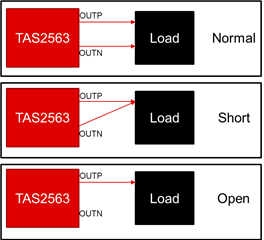
Not sure about how to use 2 reg.bin files. As I understand it, you have a power up and power down sequence in the same reg.bin, perhaps you can add a new sequence. You may start a new question so we can assign to the SW expert team, they may have better comments on how to implement a new reg.bin sequence.
Best regards,
-Ivan Salazar
Applications Engineer
Hi Ivan,
I have tried as per your connection diagram to detect short but failed to do so. It would be great if we could get a snap of your setup for the short case with the EVK and speaker connections.
Regarding the 2 reg.bin integration we have created a seperate thread.
BR,
Rekha
Hi Rekha,
I'll setup the test again and come back with the picture within a couple of days.
Best regards,
-Ivan Salazar
Applications Engineer
Hi Rekha,
Attached are the pictures for each case.
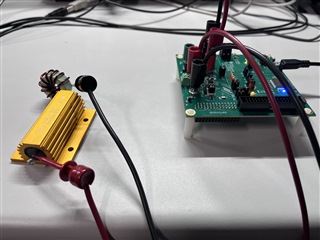
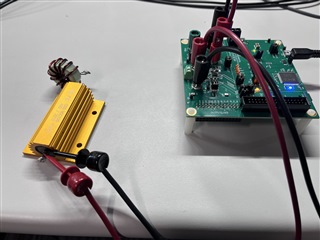
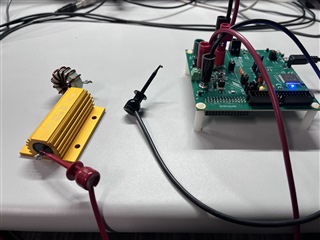
Best regards,
-Ivan Salazar
Applications Engineer
Hi Ivan,
Is this blue highlighted box below an inductor? What is the purpose of this here and the value used?
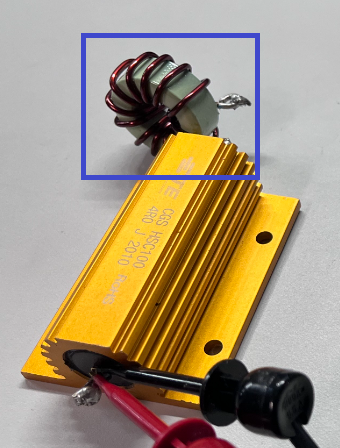
Instead of this RL combination used, can you use the speaker we had shipped to test with the EVK and let us know the results.
BR,
Rekha
Hi Rekha,
That's 33uH inductor, purpose is to emulate the resistive/inductive response of a speaker.
As far as I understand, the non-working situation on your side is the short-circuit, not the normal one. I'm I missing something?
We have several speakers shipped by your team; you may specify which one.
Best regards,
-Ivan Salazar
Applications Engineer
Hi Ivan,
Yes the non-working situation is the short-circuit case. The speaker used is CS28-02W57-07-1X (4-ohm circular one) for the test.
BR,
Rekha
Hi Rekha,
Got it. The speaker/load used for the short circuit test doesn't matter as the outputs are shorted to each other, but if needed I'll repeat the test with the actual speaker early next week.
Best regards,
-Ivan Salazar
Applications Engineer
Hi Ivan,
Did you get a chance to repeat the test with the actual 4-ohm speaker?
BR,
Rekha
Hi Rekha,
I tested with the round 4ohm speaker, and it also works OK. It reads 0x30 for short circuit, 0x20 for normal and 0x28 for open circuit.
Best regards,
-Ivan Salazar
Applications Engineer
Hi Ivan,
I am still unable to detect the short circuit on the EVK.
We are using the below version of the PPC3 tool. Kindly let us know if this version is fine or needs to be upgraded?
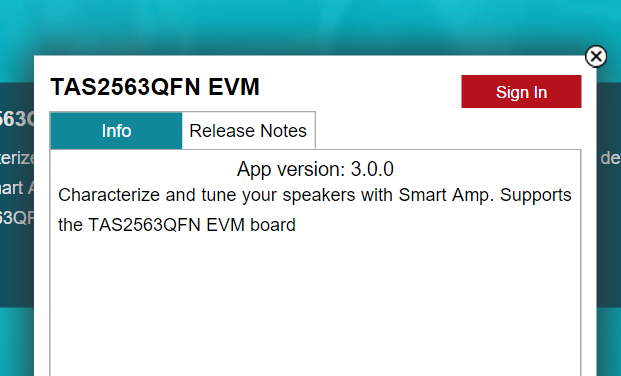
BR,
Rekha
Hi Rekha,
We're using the same version; however the version should not matter as we're only using the script mentioned in by previous post from Aug 30th:
Also, if you read 0x00 it would mean the detection sequence is not completed yet, bit 5 should be 1 if the diagnostic is completed.
Make sure you use only that script for testing, no other configuration.
Also make sure to short across the amplifier terminals, not speaker terminals. If you short speaker terminals and connect to a single terminal of the amplifier, the amplifier is actually seeing an open circuit. The amplifier only knows what happens to its own terminals.
Best regards,
-Ivan Salazar
Applications Engineer
Hi Ivan,
1. In case of short detection, we observe that before LDG is getting completed, Over current event is getting triggered. This inturn is shutting down the amplifier. We read the values in Page 0 reg 25 =0x00, reg 24=0x02 (indicates OCE interrupt), and reg 2=0x02 (shutdown). How can this be handled?
2. We have a sense resistor of 1K in the path as shown below. Does sense resistor have any dependency in load detection?
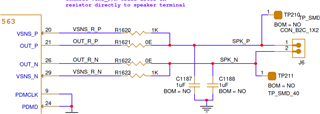
BR,
Rekha
Hi Rekha,
You can try removing those resistors on sense pins just for testing.
However, I don't expect these resistors to cause over current. If you don't run load diagnostics and just use your normal configuration for audio playback, is it also detecting overcurrent?
Best regards,
-Ivan Salazar
Applications Engineer
Hi Ivan,
1. I have tried removing the sense resistors but the result is same as above. We observed overcurrent error.
2. In case of normal configuration, there is no overcurrent detected. The below is the dump: 0x24 reads 0c.
root@tegra-ubuntu:/home/ubuntu# i2cdump -f -y 7 0x4e
No size specified (using byte-data access)
0 1 2 3 4 5 6 7 8 9 a b c d e f 0123456789abcdef
00: 00 00 00 20 ce 22 09 02 30 10 f1 02 00 04 05 06 ... ?"??0???.???
10: 07 14 13 76 01 2e 60 0e 0c 00 fc a6 df ff ff 08 ???v?.`??.???..?
20: 00 11 00 00 0c 00 11 80 00 dc 4f 00 84 d3 00 a9 .?..?.??.?O.??.?
30: 99 40 81 34 46 b4 00 00 0a 0c be 58 7c 08 10 00 ?@?4F?..???X|??.
40: 4c 41 d8 c0 10 21 00 4c ec 52 d0 00 00 00 00 00 LA???!.L?R?.....
50: 00 00 00 00 00 00 00 00 00 00 00 00 00 00 00 00 ................
60: 00 00 00 00 00 00 00 00 00 00 00 00 00 00 00 00 ................
70: 00 00 00 f0 00 0f 00 00 4f 00 00 00 00 10 86 00 ...?.?..O....??.
80: 00 00 00 00 00 00 00 00 00 00 00 00 00 00 00 00 ................
90: 00 00 00 00 00 00 00 00 00 00 00 00 00 00 00 00 ................
a0: 00 00 00 00 00 00 00 00 00 00 00 00 00 00 00 00 ................
b0: 00 00 00 00 00 00 00 00 00 00 00 00 00 00 00 00 ................
c0: 00 00 00 00 00 00 00 00 00 00 00 00 00 00 00 00 ................
d0: 00 00 00 00 00 00 00 00 00 00 00 00 00 00 00 00 ................
e0: 00 00 00 00 00 00 00 00 00 00 00 00 00 00 00 00 ................
f0: 00 00 00 00 00 00 00 00 00 00 00 00 00 00 00 00 ................
Let us know what can be done further.
BR,
Rekha
Rekha,
Do you also get OC for this test on EVM?
Previously you mentioned that you could run the diagnostic routine, but only short-circuit case was problematic. What changed?
Best regards,
-Ivan Salazar
Applications Engineer
Hi Ivan,
1. Yes, the Over current error (Reg 0x24) is seen in case of the EVK as well with short circuit case sometimes. This is only for short circuit.
2. I am able to run load diagnostic properly for normal and open case properly. The overcurrent error is only in case of short case and not in case of normal or open detection. In case of short detection, we observe that before LDG is getting completed, Over current event is getting triggered in the custom board always.
Let us know how to handle this?
BR,
Rekha
Hi Rekha,
Are you playing anything during the load diagnostic routine?
You must not play anything during this time, the diagnostic routine itself plays a pilot tone.
Best regards,
-Ivan Salazar
Applications Engineer
Hi Ivan,
No, we are not playing anything during the load diagnostic routine. The script shared is only run and the registers from Page 0 are being read where we notice the OCE being triggered.
BR,
Rekha
Hi Rekha,
Just FYI... Ivan is out of office for next 2 and half weeks. He will get involved again when he gets back.
Regards,
Nayeem
Hi Ivan/ Nayeem,
Is there an update regarding the short speaker case detection?
We are considering speaker short to be overcurrent error and implemented as part of the load diagnostic check. If 0x24 register in Page 0 indicates Bit[1]=1 then we are indicating as short. Is this implementation fine. We are interested in the speaker terminal short detection.
BR,
Rekha
Hi Rekha,
Speaker short conditions would cause overcurrent event anyways, so I agree you can use them interchangeably, this is OK.
(Still not sure why you get overcurrent event before speaker short flag during diagnostics only, this is something we couldn't replicate on our side).
Best regards,
-Ivan Salazar
Applications Engineer